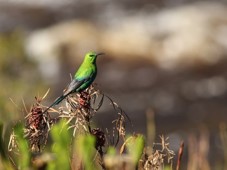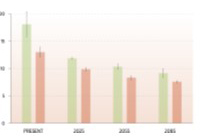
While some South African bird species are projected to expand their distributions under climate change, more are projected to contract, leading to average reductions of 30-40% in species richness of South African bird communities in grassland and fynbos by 2085. This is likely to influence the functioning of ecosystems, especially since important pollinators such as Malachite Sunbird Nectarinia famosa are projected to decline more than other species on average.

Species are expected to shift their ranges to track suitable climate as temperatures continue to rise (Huntley et al. 2007, Barbet-Massin et al. 2009, Hole et al. 2009, Araujo et al. 2011, Bagchi et al. 2013, Langham et al. 2015). It is expected that the abundance of some species may drastically decline (Huntley et al. 2012)—or even become locally extinct—if they are unable to shift or adapt, with potentially large impacts on ecosystem functioning.
South Africa is known for its high levels of endemism; fynbos and grassland are two biomes with large numbers of endemic birds and species of conservation concern, and are thought to be especially vulnerable to climate change. The biomes are however experiencing differing patterns of climate change (Huntley & Barnard 2012). The fynbos biome (South and South Western Africa) is characterized by an overall warming trend with decreasing precipitation, whilst the grassland biome (high elevations in East and South-East Africa) has shown no clear pattern in overall temperature change, but decreased rainfall and a reduction in the frequency and duration of frost (Huntley and Barnard 2012).
Climate induced changes in abundance and subsequent levels of species richness was investigated across Southern Africa using distribution data from 92 bird species, 9 of which occur in both biomes, 43 of which are endemic to southern Africa, and 12 of which are of global or regional conservation concern. Projections were made under future climate scenarios for 2025, 2055 and 2085 (Huntley and Barnard 2012).
Species richness is expected to shift southward for both biomes and the change is likely to occur on a short time scale—both the mean and median species richness for both biomes is predicted to have already declined by 12-17% by 2025. Whilst there is variation in species responses, with some species (e.g. Harlequin Quail Coturnix delegorguei) expected to gain range sizes by more than three times their current range, more are projected to contract, with average reductions in species richness of 34% by the end of the century.These changes are likely to influence the functioning of ecosystems, especially since important pollinators such as Malachite Sunbird Nectarinia famosa are projected to decline more than other species on average.
This case study is taken from ‘The Messengers: What birds tell us about threats from climate change and solutions for nature and people’. To download the report in full click here.
Related Species
References
Huntley, B. and Barnard, P. (2012) Potential impacts of climatic change on southern African birds of fynbos and grassland biodiversity hotspots. Diversity Distrib. 18: 1–13.
Compiled: 2015 Copyright: 2015
Recommended citation:
BirdLife International (2015)
Bird species richness in South African is projected to decline across different habitats.
Downloaded from https://datazone.birdlife.org/sowb/casestudy/bird-species-richness-in-south-africa-is-projected-to-decline-across-different-habitats on 22/12/2024